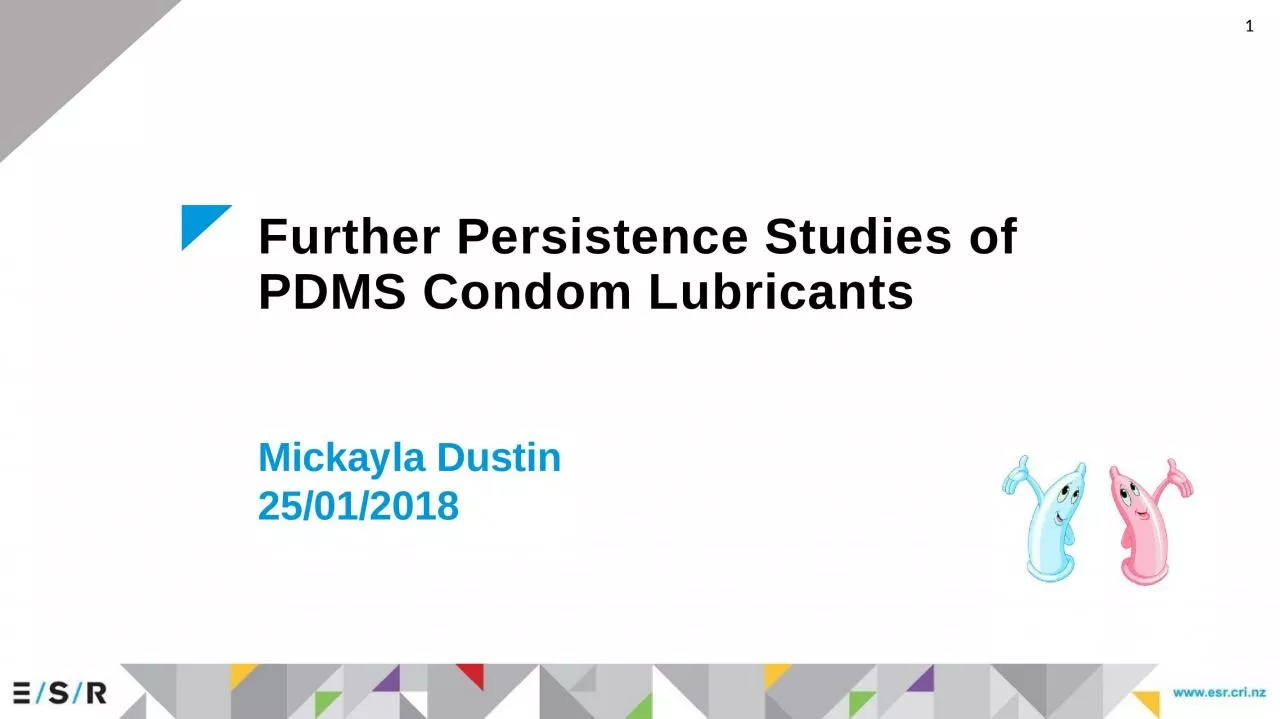

of PDMS Condom Lubricants Mickayla Dustin 25012018 1 ESR is New Zealands Crown Research Institute which specialises in science relating to people and communities 2 The Importance of Condom Lubricant Evidence and Persistence Studies ID: 1044664
Download Presentation The PPT/PDF document "Further P ersistence S tudies" is the property of its rightful owner. Permission is granted to download and print the materials on this web site for personal, non-commercial use only, and to display it on your personal computer provided you do not modify the materials and that you retain all copyright notices contained in the materials. By downloading content from our website, you accept the terms of this agreement.
1. Further Persistence Studies of PDMS Condom LubricantsMickayla Dustin25/01/20181
2. ESR is New Zealand’s Crown Research Institute which specialises in science relating to people and communities. 2
3. The Importance of Condom Lubricant Evidence and Persistence StudiesIncreasing public awareness of DNA increase use of condoms by sexual offendersRoutine request for condom lubricant analysisProvides scientific evidence to collaborate or refute a given scenarioPersistence studies are vital for interpretation3
4. Condom LubricantsThe majority of condoms in New Zealand (NZ) are lubricated with polydimethyl siloxane (PDMS), with fewer containing water-soluble lubricants such as polyethylene glycol (PEG), and glycerol.4
5. Hexane extract of swab analysed by Pyrolysis Gas Chromatography-Mass Spectrometry (PyGC-MS)Pyrolysis of PDMS dimethylsiloxane cyclic oligomersSmallest cyclic oligomer is hexamethyl cyclotrisiloxane (D3), with the oligomer series ranging from D3 to D7To identify PDMS, the D3 cyclic oligomer & at least 2 other cyclic oligomers in the D4 – D7 range must be presentESR’s Current Process5
6. Research FocusPreviously looked at:Persistence of PDMS in the vaginaThis presentation:Persistence studies on the penis, in the mouth, and on skinHow widely spread is PDMS in common products?Can we discriminate condom PDMS from other sources of PDMS?Do female hygiene products, e.g. tampons, contain PDMS?Can PDMS be detected on swabs that have previously undergone DNA extraction?6
7. Student Labour!!Masters student 1 yearIntern students3 - 6 monthsLimited timeLimited sample numbers for persistence studiesLimited time for controlling variablesUseful for knowledgeSome very interesting findings7
8. Persistence of PDMS on the Penis6 volunteers, asked to:Apply the condom to their penis for a few minutesSelf-swab their penis at a specified time interval after removal of the condomProvide information regarding their activities during the time intervalTotal of 14 swabs received – covering time intervals from 0 to 20 hoursPDMS detected at the maximum time sampled – 20 hoursActivities reported during the time intervals included sleeping, urinating, washing and exercising8
9. Persistence of PDMS on SkinVolunteers’ forearms marked into areasControl sample taken prior to PDMS transfer Condom placed on a carrot or cucumber and firmly swiped against skinOne area swabbed immediatelyVolunteers then self-swabbed each marked area after specific time intervalsAsked not to use any personal care products that contained PDMSInitial study results: 10 volunteers (2 males and 8 females)PDMS detected at 12 hours9
10. Persistence of PDMS on the Skin – Longer timeframes & washingFurther study results: 10 volunteers7 had PDMS detected at ~48 hoursMax detection time varied between volunteers from 24 to 52 hoursIntrapersonal variation was also observedNo significant affect on PDMS levels after washing with soap and waterNote: PDMS was detected on a number of control swabs taken from volunteers prior to PDMS being transferred to their forearmsSuggests these people may have PDMS on them from a personal care productIn these instances, the subsequent persistence trial swabs were not analysedImportant to establish whether or not the complainant has used any personal care products in cases10
11. Persistence of PDMS in the MouthBlank swab taken first from the inside of cheeks and on the gumsCondom placed on a carrot and volunteer moved this around in their mouth for 1 minute Volunteer self-swabbed the inside of their cheeks and gums after specified time intervalsAsked to abstain from eating or drinking during these time intervalsInitial study results: 5 volunteersPDMS detected up to 4 hours9 hours while asleep – PDMS detected11
12. Persistence of PDMS in the Mouth – Effect of Eating & DrinkingFurther study results: 5 volunteersEating and drinking permittedNo PDMS detected after eating/drinking within 1 hour of PDMS applicationEating and/or drinking removes, or at least reduces, the amount of PDMS in the mouth12
13. Study of Personal Care Products for PDMS Source Classification178 products analysed98 were positive for PDMSOther peaks often present to discriminate as non-condom PDMS13
14. Survey of Tampons for PDMSTampons: 11 different brands from the NZ marketNo PDMS detected2 applicators also analysedNo PDMS detected14
15. PDMS on Swabs Previously Extracted for DNASwabs loaded with known amount of PDMS & extracted for DNASwab RemainsPDMS found (at similar levels to control swabs)Results indicate that majority of PDMS remains on swab remainsSupernatantNo PDMS found from swabs loaded with ‘low’ to ‘medium’ amounts of PDMS‘Low’ amounts of PDMS found from swabs loaded with ‘high’ amounts of PDMSResults indicate little to be gained from extracting the aqueous supernatant15
16. Key Points - PenisPDMS detected for up to 20 hoursDetected after activities such as showering & exerciseMay be detected for longer16
17. Key Points - SkinPDMS detected for up to 24 to 52 hoursNot significantly affected by soap and waterSome volunteers had background levels of PDMSMust have control skin swabs17
18. Key Points - MouthIf awake, and no food or waterMay be detected after 4 hoursIf sleepingMay be detected after 9 hoursAppeared to be easily removed by eating and drinking18
19. Key Points - DNA analysisDNA extraction process not detrimental to the detection of PDMSSwabs can therefore be analysed for both DNA and PDMS19
20. Further researchExtensive persistence studiesImportant to publish data for incorporation into statements/evidencePersistence of PDMS in the anus and rectumMore vaginal persistence studiesPDMS on random man/woman – to establish background levels of PDMSBodily cavitiesSkin 20
21. AcknowledgementsThe studentsLaura Fabian; Heather McClelland; Murtaza SamiwalaUniversity of AucklandSuzanne van GemertAmsterdam University of Applied SciencesDave VesterSaxion University of Applied SciencesThe volunteersPE staffLeah Tottey; Gerhard Wevers; Sally CoulsonFTCoE for hosting this eventNIJ/RTI for funding my attendance21
22. Questions?22
23. Mickayla Dustin T: +64 9 845 1708 E: mickayla.dustin@esr.cri.nz23